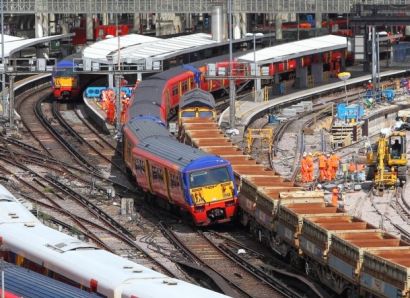THE chief inspector of railway accidents has warned that the low-speed collision between a passenger train and wagons at London Waterloo last summer has revealed ‘a deep-seated problem’.
Simon French of the Rail Accident Investigation Branch said the incident on 15 August, which involved an early morning train and stationary engineering wagons, has aroused fears that the lessons of the fatal triple collision near Clapham Junction on 12 December 1988 ‘may be fading from the railway industry’s collective memory’.
A technician had left signalling near Clapham in a dangerous condition, because new circuits had been installed but the old wiring was still connected at one end and loose and uninsulated at the other. The result was that a signal did not turn to red when the section it was protecting was occupied, and this caused a rear-end collision. A third train running empty collided with the wreckage moments later. The accident happened at the height of the morning rush hour: 35 people were killed and 69 seriously injured. More than 400 others were slightly hurt.
The resulting inquiry found serious flaws in the design, modification, testing and commissioning of signalling systems, and this finding led to major changes.
The RAIB said the Waterloo crash last year, in which no-one was hurt, was also caused by ’uncontrolled’ wiring changes, and this has raised ‘concern that some of the lessons identified by the public inquiry following Clapham may be fading from the railway industry’s collective memory’.
Simon French said: ‘The disastrous collision at Clapham Junction was a turning point. The immediate cause of the accident was poor working practice by a signalling technician, and the public inquiry highlighted serious deficiencies in the management of safety.
‘The recommendations of the inquiry fundamentally changed several aspects of how the railway is run, and for signal engineers one of the most important was the approach to routine tasks, such as testing alterations to signalling installations. It was therefore concerning for RAIB to discover, during our investigation of the collision at Waterloo last year, that some of these important changes were not reflected in the way that signalling modifications were being undertaken.
‘Some of the people involved did not keep proper records of temporary works, or ensure that additional temporary wiring was shown on the design documents. Leaving that temporary wiring when it should have been removed led to a passenger train being diverted on to a blocked line and colliding with wagons. Compliance with the existing standards, developed since Clapham, would have provided the controls needed to stop temporary wiring being installed and used in the uncontrolled manner which resulted in this accident.’
The RAIB has made separate recommendations to Network Rail and the two contractors on site, OSL Rail and Mott MacDonald.
Network Rail said: ‘The Waterloo derailment was a wake-up call for us, and our contractors, and highlighted that we can never afford to be complacent when it comes to keeping our passengers and workforce safe. Today we enjoy an enviable safety record that is second to none across Europe, but that record has been hard won through focus and action.
‘The lessons of Waterloo have already been shared across the industry and these recommendations will help further.’


